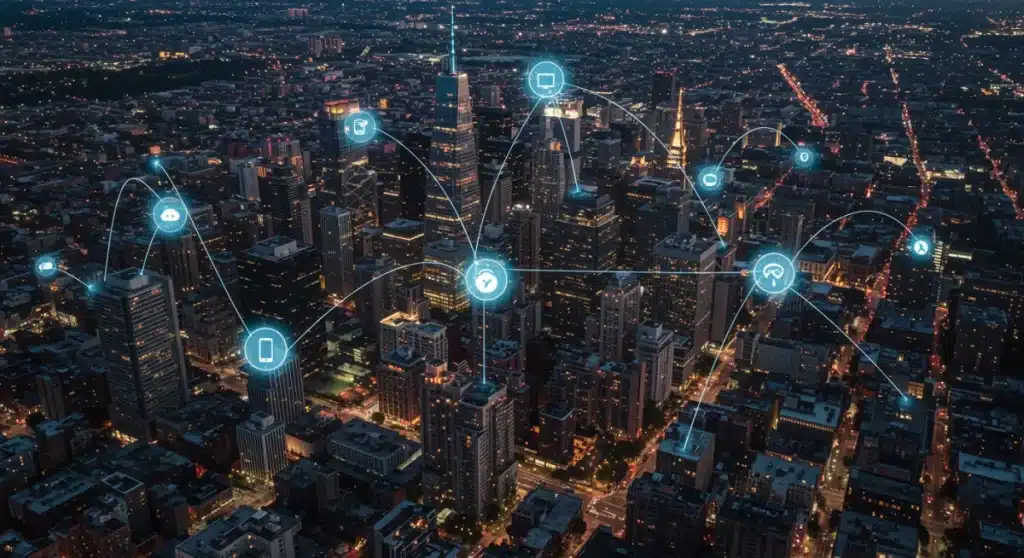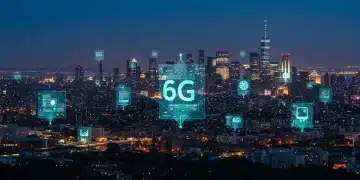Smart Cities Tomorrow: IoT Infrastructure Expansion in US Urban Centers

US urban centers are projected for a 30% expansion of IoT infrastructure by 2028, transforming smart cities with enhanced connectivity and data-driven services.
Breaking news reveals a significant acceleration in urban technological advancement: a projected 30% expansion of Smart Cities of Tomorrow: Projecting a 30% Expansion of IoT Infrastructure in US Urban Centers by 2028. This ambitious forecast signals a pivotal shift in how American cities will operate, delivering enhanced efficiency, sustainability, and quality of life for residents.
Understanding the IoT Infrastructure Surge
The anticipated 30% expansion of IoT infrastructure by 2028 marks a critical milestone for smart city development in the United States. This growth isn’t merely about adding more devices; it signifies a deeper integration of interconnected technologies designed to optimize urban living across various sectors.
This surge is driven by a confluence of factors, including rapid technological innovation, increasing demand for data-driven urban solutions, and significant public and private sector investments. It promises to redefine the operational blueprints of major US urban centers, from traffic management to public safety.
Key Drivers of IoT Growth
Several fundamental elements are propelling this unprecedented growth in urban IoT. Understanding these drivers is crucial to grasping the scope and potential impact of the projected expansion.
- Government Initiatives: Federal and local governments are increasingly funding smart city projects, recognizing the long-term benefits in efficiency and citizen services.
- Private Sector Investment: Technology giants and startups are pouring capital into developing and deploying IoT solutions, creating robust ecosystems for urban innovation.
- Advancements in Connectivity: The rollout of 5G and future wireless technologies provides the necessary high-speed, low-latency backbone for massive IoT deployments.
- Data Analytics Capabilities: Improved AI and machine learning allow cities to effectively process and leverage the vast amounts of data generated by IoT devices, turning raw information into actionable insights.
Impact on Urban Mobility and Transportation
One of the most immediate and visible impacts of expanded IoT infrastructure will be on urban mobility and transportation systems. Cities are grappling with congestion, pollution, and inefficient public transit, and IoT offers transformative solutions.
By integrating sensors, cameras, and real-time data analytics, urban planners can create more responsive and adaptive transportation networks. This includes everything from intelligent traffic signals that adjust to real-time flow to advanced public transportation systems that predict demand and optimize routes.
Smart Traffic Management Systems
The evolution of traffic management is central to the smart city vision. IoT-enabled systems collect data on vehicle density, pedestrian movement, and even air quality, feeding into algorithms that proactively manage traffic flow.
- Dynamic Signal Timing: Traffic lights will no longer operate on fixed schedules but will adapt based on current conditions, reducing wait times and congestion.
- Parking Guidance: Sensors in parking lots and on streets will provide real-time availability information to drivers, minimizing circling and associated emissions.
- Public Transit Optimization: Buses and trains can be tracked in real-time, with schedules adjusted to meet demand, improving reliability and passenger experience.
These systems are designed not just for efficiency but also for safety, with rapid incident detection and response capabilities becoming standard across connected urban environments.
Enhancing Public Safety and Emergency Response
The expansion of IoT infrastructure is poised to revolutionize public safety and emergency services within US urban centers. Real-time data and interconnected devices offer unprecedented capabilities for crime prevention, rapid response, and disaster management.
From smart surveillance systems to environmental sensors, cities are deploying technologies that provide a more comprehensive and immediate understanding of developing situations, enabling faster and more effective intervention by first responders.

Proactive Safety Measures
IoT devices are moving beyond reactive responses to enable proactive safety measures. This includes identifying potential hazards before they escalate and providing early warnings to residents and authorities.
For example, sensors can detect unusual patterns in public spaces, while connected infrastructure can monitor for structural integrity issues in bridges or buildings. This shift towards predictive safety is a hallmark of advanced smart cities.
- Connected Surveillance: AI-powered cameras can identify suspicious activities or unattended packages, alerting security personnel instantly.
- Environmental Monitoring: Sensors tracking air quality, water levels, and seismic activity provide crucial data for disaster preparedness and response.
- Smart Streetlights: Beyond illumination, these can integrate cameras, environmental sensors, and even act as Wi-Fi hotspots, enhancing surveillance and connectivity in public areas.
Sustainability and Environmental Management
A significant portion of the IoT infrastructure expansion is directly aimed at fostering greater urban sustainability and more effective environmental management. As cities face increasing pressures from climate change and resource depletion, IoT offers tools to build greener, more resilient communities.
This involves optimizing resource consumption, monitoring environmental conditions, and promoting eco-friendly behaviors through data-driven insights. The goal is to create urban ecosystems that are both efficient and environmentally responsible.
Resource Optimization Through IoT
IoT devices are fundamental to achieving efficiency in energy, water, and waste management. Smart grids, intelligent water systems, and automated waste collection are becoming standard features in forward-thinking urban centers.
For instance, smart waste bins can signal when they are full, optimizing collection routes and reducing fuel consumption. Similarly, smart meters provide real-time data on energy and water usage, empowering both utilities and consumers to manage resources more effectively.
- Smart Energy Grids: These systems balance electricity supply and demand, integrate renewable energy sources, and reduce waste through real-time monitoring.
- Intelligent Water Management: Sensors detect leaks in pipelines, monitor water quality, and optimize irrigation in public spaces, conserving precious resources.
- Waste Management Efficiency: Connected bins and optimized collection routes significantly reduce operational costs and environmental impact.
Challenges and Considerations for Implementation
While the projected 30% expansion of IoT infrastructure offers immense benefits, its implementation in US urban centers is not without significant challenges. Addressing these hurdles is critical for ensuring successful, equitable, and secure smart city development.
Key considerations include data privacy, cybersecurity, interoperability between diverse systems, and the digital divide. Cities must navigate these complexities to realize the full potential of their IoT investments.
Overcoming Implementation Hurdles
Effective planning and robust policies are essential to mitigate the risks associated with large-scale IoT deployments. This involves collaboration between city governments, technology providers, and community stakeholders.
Establishing clear data governance frameworks and investing in resilient cybersecurity measures are paramount. Furthermore, ensuring that all residents can benefit from smart city initiatives, regardless of socioeconomic status, is a significant ethical consideration.
- Data Privacy Concerns: Protecting citizen data collected by IoT devices requires stringent regulations and transparent policies.
- Cybersecurity Risks: The vast network of interconnected devices presents a larger attack surface, necessitating advanced cybersecurity protocols.
- Interoperability Standards: Ensuring different IoT systems and platforms can communicate seamlessly is crucial for integrated urban management.
- Digital Inclusion: Bridging the digital divide to ensure all communities have access to and benefit from smart city technologies.
Economic and Social Implications
The rapid expansion of IoT infrastructure in US urban centers carries profound economic and social implications. This growth is expected to stimulate local economies, create new job opportunities, and redefine the relationship between citizens and their urban environment.
From fostering innovation ecosystems to improving access to information and services, the smart city transformation has the potential to elevate the quality of life and economic dynamism in cities across the nation.
New Economic Opportunities
The development and deployment of IoT technologies are creating a burgeoning market, attracting investment and fostering innovation. This includes opportunities in hardware manufacturing, software development, data analytics, and specialized urban planning.
Local businesses can leverage IoT data to better understand customer behavior and optimize operations, while startups can emerge to fill niche service gaps created by the new technological landscape. This economic uplift is a key benefit of smart city initiatives.
- Job Creation: Demand for skilled professionals in areas like data science, cybersecurity, and IoT engineering is rapidly increasing.
- Innovation Hubs: Cities become fertile ground for technological innovation, attracting companies and talent.
- Improved Public Services: Data-driven insights lead to more efficient and responsive public services, enhancing citizen satisfaction.
- Enhanced Quality of Life: Reduced congestion, safer environments, and better resource management contribute to a higher overall quality of urban living.
| Key Aspect | Brief Description |
|---|---|
| IoT Expansion Target | US urban centers project a 30% increase in IoT infrastructure by 2028. |
| Core Benefits | Improved urban mobility, enhanced public safety, and greater sustainability. |
| Key Challenges | Addressing data privacy, cybersecurity, and ensuring digital inclusion. |
| Economic Impact | Creation of new jobs, fostering innovation, and driving economic growth. |
Frequently Asked Questions About Smart City IoT Expansion
For average citizens, this expansion translates to more efficient public services, reduced traffic congestion, improved public safety through real-time monitoring, and better environmental quality. It aims to make daily urban life smoother and more connected.
The IoT expansion is expected to create numerous job opportunities in technology development, data analytics, cybersecurity, and infrastructure management. It will also require new skill sets for maintaining and operating advanced urban systems.
Key challenges include ensuring data privacy and cybersecurity, achieving interoperability among diverse IoT systems, securing adequate funding, and addressing the digital divide to ensure equitable access to new technologies and services.
IoT will enhance sustainability through smart energy grids, optimized waste management, and intelligent water systems, leading to reduced resource consumption and lower carbon emissions. Environmental sensors will also monitor air and water quality.
While specific leaders vary, cities like New York, Los Angeles, Chicago, and particularly smaller, innovative hubs are actively investing in IoT. Early adopters demonstrate significant progress in integrating smart technologies into their urban frameworks.
Looking Ahead
The projected 30% expansion of IoT infrastructure in US urban centers by 2028 is not merely a technological forecast; it’s a blueprint for the future of urban living. This development will fundamentally reshape how cities function, demanding continued innovation, robust policy frameworks, and vigilant attention to ethical considerations like data privacy and equitable access. As these initiatives gain momentum, the focus will shift towards ensuring that the benefits of smart city technologies are universally realized, fostering communities that are not only technologically advanced but also inclusive and sustainable for all residents.





